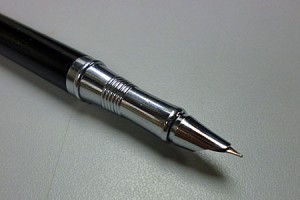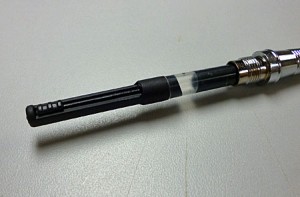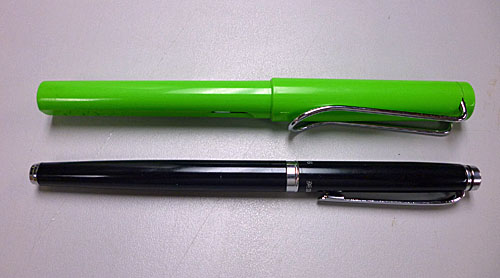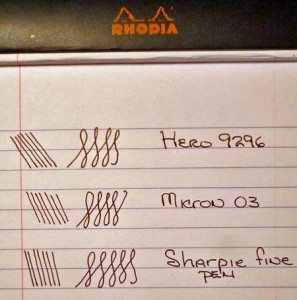A couple days ago I promised a review of the Hero 9296, a fountain pen I’ve purchased recently. I bought it for two reasons. First, my buddy Yvan started using one to do his quick sketches and while Yvan’s favorite pen is always the one he just acquired, he’s stuck with this one for a while. The second reason is more important for anyone reading this – it’s CHEAP! I bought it via eBay for $7.00, including the shipping.
I’d like to say that this pen has bumped my Pilot Preras and TWSBI Minis into the closet but that’s not the case. I present it here for two reasons. Did I mention that it’s CHEAP? For the price of a couple lattes you can have a fine-writing (pun-intended) fountain pen. The second reason is that this pen is a very thin, but normal length fountain pen, favored by those with smaller hands. It has a metal body and silver trim. If you like thin pens, this one is worth a look.
I bought what Hero calls an “extra-fine” nib and I was surprised to find that though it’s an Asian company, the nib is more like a typical Asian “fine” nib. This is not a knock against it, but the Pilot Penmanship XF produces a finer line. This pen, at least with Noodler’s Lexington Gray is very similar to a Micron 03 in line width. It writes wetter than my Pilot Preras and so Lex Gray looks darker from this pen than from my Preras. I think most would find it quite respectable and usable for most sketching. My Pilot Preras produce a bit finer line than this pen but I think most of that is due to the wetter line from the the Hero 9296.
 There are a couple things I don’t like about this pen but they may not bother others. First is the nib/grip. It is very shiny and, if you’re an outside sketcher like I am, this can be a problem on a sunny day. The fact that the pen is hooded combines with the shine to create a pen where it’s hard to tell if/when the nib is oriented properly. Anyone who has used a fountain pen knows that rotating the nib of the pen can greatly affect how or even if it will write. Maybe you get used to it.
There are a couple things I don’t like about this pen but they may not bother others. First is the nib/grip. It is very shiny and, if you’re an outside sketcher like I am, this can be a problem on a sunny day. The fact that the pen is hooded combines with the shine to create a pen where it’s hard to tell if/when the nib is oriented properly. Anyone who has used a fountain pen knows that rotating the nib of the pen can greatly affect how or even if it will write. Maybe you get used to it.
 The pen comes with a converter, which is normally a plus. In this case the converter is different from more typical Hero converters in that it is 1) thinner, providing less capacity and 2) rather than a threaded plunger, it has a slide plunger that I find clumsy to operate. I’m not sure why but the result is that you can’t get the converter more than 1/2 – 3/4 full, further reducing how much ink the pen holds.
The pen comes with a converter, which is normally a plus. In this case the converter is different from more typical Hero converters in that it is 1) thinner, providing less capacity and 2) rather than a threaded plunger, it has a slide plunger that I find clumsy to operate. I’m not sure why but the result is that you can’t get the converter more than 1/2 – 3/4 full, further reducing how much ink the pen holds.
These drawbacks aside, this is a good pen for not much money. I’m going to fill mine with a washable ink (my pens are typically filled with waterproof inks) to give me another tool in the arsenal.









 The typical, modern fountain pen uses an ink cartridge. These are convenient, but they do have a few drawbacks. They contain very little ink, typically half a milliliter or less. You are also limited by the colors and kinds of ink available in cartridge form. Cartridges are also the most expensive way to feed a fountain pen.
The typical, modern fountain pen uses an ink cartridge. These are convenient, but they do have a few drawbacks. They contain very little ink, typically half a milliliter or less. You are also limited by the colors and kinds of ink available in cartridge form. Cartridges are also the most expensive way to feed a fountain pen. So, many people replace the cartridge with a converter that allows you to suck up ink from a bottle and so your choices improve and your costs drop considerably.
So, many people replace the cartridge with a converter that allows you to suck up ink from a bottle and so your choices improve and your costs drop considerably. And so the “eyedropper pen” is born, taking its name from the way you fill the barrel of the pen – with an eyedropper. Here is my editing pen. Everyone knows that editors use a lot of red ink so it’s a natural for eyedropper pen conversion.
And so the “eyedropper pen” is born, taking its name from the way you fill the barrel of the pen – with an eyedropper. Here is my editing pen. Everyone knows that editors use a lot of red ink so it’s a natural for eyedropper pen conversion. You can buy these at Home Depot but what they have available are thicker than is generally desireable. While they will work, they create an unsightly lump along the body of the pen. I bought a bunch of proper-size washers from
You can buy these at Home Depot but what they have available are thicker than is generally desireable. While they will work, they create an unsightly lump along the body of the pen. I bought a bunch of proper-size washers from 